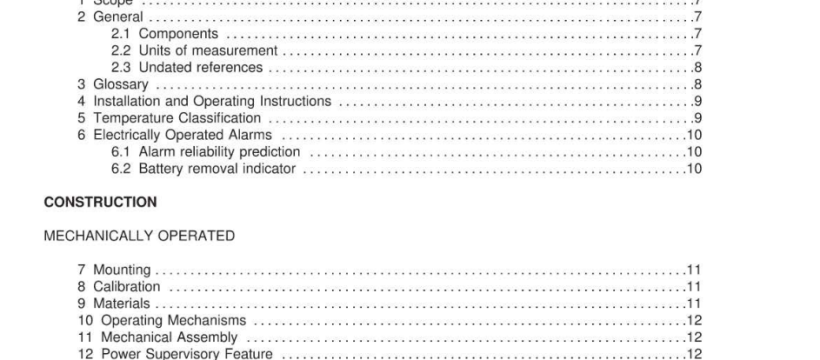UL 539-2009 pdf download.Single and Multiple Station Heat Alarms.
3 Glossary For the purpose of this standard the following definitions apply. 3.1 ALARM SIGNAL – An audible signal intended to indicate an emergency fire condition. 3.2 3.3 COMPONENT , Ll MITED Ll FE – A component that is expected to fail and be periodically replaced and whose failure is supervised. Typical examples of such components include incandescent lamps , electronic tube heaters , functional heating elements , and batteries. See also 41 .4. 3 .4 COMPONENT , RE Ll ABLE – A component that is not expected to fail or be periodically replaced and is not supervised. A reliable component shall have a predicted failure rate of 2.5 or less failures per million hours. 3.5 HEAT ALARM , SINGLE STATION – A self-contained fire alarm system comprising of a heat alarm , an alarm sounding device , and a stored energy source (wound spring) incorporated in one integral package. 3.6 MECHANICALL Y-OPERATED-TYPE – A heat alarm having a temperature sensitive bimetal or eutectic element and a spring-wound-type mechanism with clapper mounted within a bell housing. The snap action of the bimetal or melting of the eutectic element releases the spring mechanism resulting in a bell-type sound. RISK OF ELECTRIC SHOCK – A risk of electric shock is determined to exist at any when: 3.7 a) The potential between the ground or any other accessible more than 42 .4 volt peak and b) The continuous current flow through a 1 500 ohm resistor connected across the potential exceeds 0.5 milliampere. RISK OF FIRE – A risk of fire is determined to exist at any point in a circuit where: 3.8 a) The open circuit voltage is more volt peak , and the energy available to the circuit under any condition of load , including short circuit , results in a current of 8 amperes or more after 1 minute of operation or b) A power of more than 1 5 watts is deliverable into an external resistor connected between the two points.
6 El ec tri c all y Op erated Ala rms 6 .1 Ala rm relia bil ity pre di ct ion 6.1.1 The maximum failure rate for electrically operated alarm units sha ll be 4.0 failures per million hours as calculated by a full analysis prediction as described in Section 2.0 of MIL-HDBK 21 7B (20 September 1 974) or 3.5 failures per million hours as calculated by a simplified count reliability prediction as described in Section 3.0 of MIL-HDBK 21 7B , or equivalen t. A “Ground Fixed” (GF) environment is to be used for When actual equivalent data is available from the manufacturer , it shall be used in lieu of the projected data for the purpose of determining reliability. 6.1 .2 Any component whose failure results in energization of an audible trouble signal , energization of a separate visual indication (orange or yellow) , de-energization of a power-on light , or: a) Does not affect the normal operation or b) Is evaluated by specific performance tests included in this standard does not require inclusion in the failure rate calculation. Examples include the audible signal appliance , thermostat , test switch , and battery contacts. 6.1 .3 An integral or remote accessory , such as an integral transmitter or remote sounding appliance , is no t required to be included in the reliability prediction except for those components whose failure affects the normal opera ti on of the alarm. 6.1 .4 A custom integrated circuit used in an alarm shall have a predicted failure rate of not greater than 2.5 failures per million hours. The failure rate is to be determined through evaluation of data in a 3000-hour burn- in test , or equivalen t.
6.2 Batt e ry removal i nd i cator 6.2.1 Removal of a battery from a (or AC with battery back-up) heat alarm shall result in a readily apparent and prominent visual indication. The visual indication shall consist of: a) A warning flag that is exposed with the battery removed and the cover closed; b) A hinged cover that is resistant to being closed with the battery removed or c) An equivalent arrangemen t. (Such as an audible trouble signal on an AC with battery back- up). 6.2.2 Removal of a battery from a battery-operated (or AC wi th battery back-up) heat alarm that is intended to be removed from its mounting location for battery replacement , shall render the un it resistant to reinstallation. 6.2.3 When a warning flag , or equivalent , is employed to comply with the requirement of 6.2.1 or 6.2.2 , it shall be marked as required in 61 .2.UL 539-2009 pdf download.
UL 539-2009 pdf download
